Farming & Dams
Columbia River Basin
|
NEW ESRI StoryMaps: What's On Our Shelves & NWNL Song Library & No Water No Life ESRI |
Columbia River Basin
Bryan L. Jones
Dryland Wheat Farmer
Alison M. Jones
NWNL Director and Photographer
About Bryan Jones
Dryland Farming In the Palouse
Cattle Farming: Considering Impacts
Irrigated Farming
Aquifers and Groundwater in the Palouse and Texas
Dams and Transportation: River, Road, or Rail?
Dam Removal Options: Constraints and Benefits
Creating Awareness: Stewardship and Win-Win Negotiations
Anytime there's erosion into the waters, chemicals go in and sediment goes in. What happens when 700 different chemicals float downstream to the mouth of the Columbia? If we can save our soil and improve our heritage, that's a good thing. --Bryan L Jones: No-till wheat farmer in The Palouse, WA
All images © Alison M. Jones. All rights reserved.
NWNL Hi Bryan and thank you for welcoming us into your farmhouse here in the rolling hills of the Palouse. Have you always lived in the Snake River Basin?
BRYAN JONES My great-grandfather was mostly a sheep farmer, and we started farming this country in my grandfather’s day. I grew up on this farm, which was established in 1868. I spent some of my childhood at Penawawa on the north banks of the Snake River and having fruit fights with my brothers. Throwing big, grapefruit-sized peaches at each other and splatting each other with fruit all the time. It was great. It was a wonderful community. Things grow there that don’t grow here in Dusty: peaches, fruit, vegetables – and watermelon just take off and conquer the ground. Now, I’m a fourth-generation wheat, cattle, and sheep farmer here in Dusty, Washington. And I’m still moving this little farm forward.
NWNL Did you always know you wanted to be a farmer?
BRYAN JONES I moved away from the farm when I went into the Navy right out of high school and that was a great experience. I recommend it for everybody, even though you’ll hate the military. I knew I wanted to do something else. I went on to Gonzaga University in Spokane and then to Los Angeles for a while. I came back up here with a family and started teaching special education. I taught for six years and farmed on the weekends. But I realized I was going crazy and my life was going to hell. So when my father had his five-way bypass, I decided this was a good time to take a holiday and just farm. What a silly boy!
NWNL How have you seen farming evolve here in the Palouse?
BRYAN JONES Our family plowed, burned, and cleared the soil any way we could. And we found that this beautiful, beautiful soil is just great for erosion. My grandfather and my father both used conventional tillage. We plowed the soil, we disked the soil, we worked it, and we made gardens. We just made a garden of our fields. Wheat came up and grew wonderfully. But we were losing a lot of soil every year. Not only to water erosion, but also to wind erosion. As a child, I remember growing up here and having the sun blocked out by dust in windstorms.
BRYAN JONES I’ve been farming full-time since about ’96. It’s been an interesting road. There are a lot of great new things in agriculture today. We’ve done wonderful things for our soils by reducing our pesticide use and putting on cleaner, better pesticides that aren’t going to necessarily stay in the ground forever. I think the science is what pushes us forward and that’s important.
If we can save soil, improve our heritage and make something last into the future, that’s a good thing. I’m currently a no-till farmer and I try to only use as few chemicals as I can, when I can. There are times when I feel I need to use certain chemicals; but at least now they’re not going down the hill with the soil any more. That’s a nice improvement. What makes me feel good is that since I can be more accurate with my use of chemicals and the soil is no longer pulverized, fewer chemicals are running off my fields and into streams.
Agricultural ditches
NWNL Was wind erosion as much of a problem as water erosion?
BRYAN JONES Wind erosion certainly was a problem. When you got your soil fine enough, it loved to take off. Every time you stirred the soil, there was soil going into the atmosphere. Our current system keeps the ground intact. We don’t chew it up any more because we seed right into the previous year’s crops. Thus we save moisture, the structure of the soil, and organisms that are in the soil. These improvement are proving to be really, really valuable.
I can remember my first few years of farming. Since I live along the road, of course, everybody gets to critique how I farm my ground. And so, consequently, there have been guys who have gone out to dig in my soil. They would come to me and say, “You have worms! You have worms in your dirt!” Yeah, I do. That’s just one indicator of all of the other stuff that’s going on in there.
But water erosion was probably a far greater problem. The eroded ditches that I grew up with just tore up machinery and were difficult all year. You had to look at those scars every spring. Oh, it was terrible. All of a sudden though, when we stopped tilling, all the great soil didn’t go down the hill. Granted, we do have weather events that give us trouble. But most of the time, we save a lot of soil. And I really think we’re probably building soil.
NWNL How does no-tilling and intact soil make a difference?
BRYAN JONES By not tilling, we save the health of the soil in two ways: by preventing both water erosion and wind erosion. We find that we can raise wheat here wonderfully that way. It’s economics, really. We save money and it adds to the quality of my life. No-till farming means I can be sitting here having another cup of coffee, rather than sitting out on my tractor tilling my soil again and again. That’s really a wonderful thing. I feel really privileged to grow up in this time where science is teaching us that we can do this.
NWNL I understand that if you mix up the soil, you’re losing its structure. It doesn’t have the water pockets. Could you explain a bit more how you lose the structure when you mix up, or till, the soil.
BRYAN JONES A scientist once told me that if your campfire is growing low, you can gain more fire if you stir it with a stick. Then it burns red hot and the heat comes off. But, eventually, it burns right down to nothing. That’s a little bit like soil. When you stir that soil up by tilling it, it’s in great shape and it absorbs all of those nutrients really quickly. But all of those little micro-bacteria and organisms that are living there get destroyed as you chew up the soil. Yes, you grow a nice crop of wheat; but looking long-term into the system, you’re burning your soil. Granted, it could take perhaps hundreds of years to do that. But I’ve heard that with tilling we’ve lost six feet of soil from this ground. That’s really shocking. Even if we’d only lost two feet, I’d find it shocking.
NWNL I read one analysis that said that 40% of the soil had eroded after farming had started here.
BRYAN JONES I’m not surprised.
NWNL Do you “dirty farm?”
BRYAN JONES I don’t think I “dirty farm” – but I don’t know what that term means.
NWNL Ahh. In South Dakota some farmers “dirty farm” by letting the weeds grow up between their crop rows. Neighbors, who were “clean farming” by putting Roundup [a glyphosate herbicide] between their rows, called this “dirty farming.”
BRYAN JONES I don’t have any row crops, so I don’t really “dirty farm.”
Iconic scenes in the Palouse
NWNL Do you use Roundup?
BRYAN JONES I use Roundup readily. I have one mode of action and Roundup is great. It allows me to no-till farm today. I don’t know how I would do it otherwise. I have grown Monsanto’s World Conquering Wheat; however I have stepped back from that. It’s not as effective as I’d like it to be.
NWNL Is there a certain kind of wheat that’s better for no-till dryland farming?
BRYAN JONES For all of you non-farmer types, I’m going to tell you this: wheat changes. Every generation. Every year, I have five or six different kinds of wheat that I could raise. Every year, I can pick out ten new different kinds of peaches I can raise. That happens with everything from New Mexico peppers to every other crop out there. Scientists are always looking to raise a better “something.” And wherever a crop grows really well, somebody’s working on making it better. Trifecta is the wheat variety I’m using this year. Two years ago, I was using different wheat. I will continue to transition through different kinds of wheat that people use and that scientists say are good crops.
NWNL It seems that on realizing the effects of erosion, many farmers voluntarily started no-till seeding, strip-cropping, creating terraces and waterways, and putting in trees and shrubs. How did that correction happen?
BRYAN JONES I think the science led farmers and the government to put in place certain elements to try when and where they were appropriate. We started putting grass strips on our farm. We started splitting the hillsides. We split slopes and divided them in half so we didn’t have the same kind of crop all of the way down the width of a field.
Spring fields in the Palouse
BRYAN JONES Farmers here started testing some of the earliest no-till cropping systems in 1974, I think. No-till farming wasn’t received very well then, and farmers went on without it. But in the early ‘90s, people started looking at no-till again, saying, “Hmm, how can we make this work?”
Benefits from the process of conversion don’t happen over night. You improve your soil over time. Two or three years into no-till, you’ve got some pretty good ground to re-seed into. Then about that time, another problem crops up. A weed or a pest comes into the scenario that you have to fight. So, you turn around and rethink it.
I don’t think there is a perfect no-till scenario. There are some good ones – and there are some that just have a place with spring or fall seeding. Dryland farming has a lot of variables that depend on the one thing we need most – rain. If it’s raining, then we can all raise wheat. But if it’s not raining, then we’ve got a challenge.
NWNL How many people are still disking, rather than adopting no-till farming?
BRYAN JONES I think Whitman County has a fairly high percentage for conventional farming. It always surprises me that others haven’t tried no-till. I think it has to do with economics, with what your father did, and with what you’re set up to do. I wish more farmers would change. Some of the big farmers I know who are still doing conventional farming really should convert. Those guys that are farming lots of acres have lots of equipment. They’ve got a system that works for them, but I wish that they could make the transition and save the soil. There are big farmers doing no-till, not just little farmers; and lots of us are doing it well.
NWNL What convinces farmers to change to no-till?
BRYAN JONES Changing to no-till may come from neighbors: because I’m a neighbor of a neighbor, who’s a neighbor of a neighbor. We’re all neighbors here. There are conventional farmers on my borders; there are no-till farmers on my borders; and there are farmers that do a little bit of both who seem to be doing quite well. I understand that occasional tilling of the soil is not a terrible thing. There are different things that work. I just think not experimenting with the no-till opportunity is unfortunate because the possibilities are great.
Palouse agriculture
NWNL Are there governmental or other incentives to turn to no-till?
BRYAN JONES There are, but they do tie you in. Incentives mean you must attend to some paperwork and track what you are doing. I’m just quitting a four-year stint with an EQUIP Program [Environmental Quality Incentive Program] through the NRCS [National Resource Conservation Service]. Yeah, there are some times that I have to sit down and do some paperwork. It’s not always the yippie-kay-yay thing that you’d like to be doing. But I think that no-till benefits have really been great. I know that I’ve saved soil – and that’s good.
NWNL How does soil erosion affect local waterways?
BRYAN JONES Anytime that you have erosion going into the waters, you have issues of what chemicals are going in, how much sediment’s going in, and what’s in that water. By themselves, oil and chemicals may be one thing. But what happens when you have 700 different chemicals floating downstream to the mouth of the Columbia? What happens when those different combinations mix together? Chemicals come from all across the Pacific Northwest: from dryland farming on the very east, irrigated farming in the central part of the state, and large runoffs on the west side of the state where there’s lots of water and the potential for greater erosion.
Chemical applications for agriculture
BRYAN JONES I hope some day that we’ll know better what the mix of 700 chemicals in the Columbia does. And I hope it’s not as bad as I dream it could be. I do know what putting five chemicals in one tank of spray can do if you don’t put them in the right way. If you mix them incorrectly, you have Jello in a big plastic tank. That’s not fun – and it’s not really Jello. “Jello” is too polite a word. Sludge, slush, and goo? It affects every element of life in a water system. Soil chokes out young fish and smothers eggs. Add chemicals to the equation and who knows what might happen? Six-legged frogs? There is a whole pyramid of life to be affected. We do ourselves a great injustice to assume we understand how all things work.
NWNL What are impacts of agriculture on runoff into streams? Does it change the peak run-off patterns or the length of time of your runoffs? Does it increase the flow?
BRYAN JONES Yes, natural, undisturbed soil holds more moisture. For example, in a forest, soil will hold more moisture if it hasn’t been chewed up by logging and if it hasn’t had roads cut through it. Water gains speed going downhill, and that increases erosion.
I have a great example behind me of two hillsides that probably total 100 acres. Half is from my land while the other is from my neighbor. Last winter, when water from my field, or “draw,” was flowing quickly through my barn yard, I could go up to those 100-acre fields, and see the runoff. My neighbor’s draw joins my draw. His land had a fast-moving, chocolate-brown river flooding into my field. Because his wasn’t a no-till situation, a lot more water and mud was running downstream into the water system. My draw on the other hand had no runoff and the very bottom of the draw was still white with snow.
Palouse fields
NWNL Is anyone documenting this difference of runoff from tilled versus no-till fields?
BRYAN JONES Over the years, we’ve seen lots of erosion. There were ditches in which you could bury a truck. We’ve all changed. I think that every farmer has changed how he farms. We’re certainly not burning stubble fields as in the past. The government really challenges us not to do as much burning. Science says that burning is an efficient way of getting a lot of trash out of the way, but that’s not necessarily a good thing. Everybody farms with the idea that we want to at least to keep as much organic matter as possible. Many farmers are becoming more aware; but some aren’t.
NWNL What motivates farmers to care about new farming methods?
BRYAN JONES Ask thirty farmers in this community, “Why are you farming?” Probably most of them would say, “I’m farming for myself, and I’m farming for my heritage. I’m hoping to pass this on to family members – my children – and have it a good place to raise family in the future.”
There are many kinds of farmers. They may be cattlemen. They may be wheat farmers. They may just farm one crop, like wheat. They may be a diversified farmer, like myself, who has a little bit of everything. Almost irrespective of the kind of farmers we are, we are all well intentioned. Our best science can lead us in directions we don’t necessarily follow. I don’t begin to follow all of the science. That’s not my goal. My goal is to do a good job for this land where I live and work. I consider the science, but at times I do not agree with all the science for one reason or another.
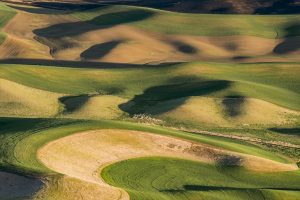
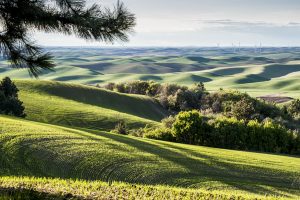
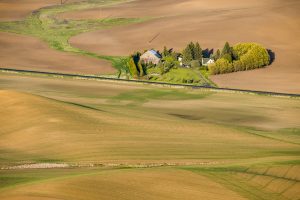
More Palouse fields
NWNL You farm cattle as well as wheat. What is the effect of cattle on the land here? Do they pack down the soil? Do they stir it up with dust? Does their presence tend to lead to invasive species?
BRYAN JONES I raise cattle and I do what I can. I’m aware that cattle can chew up stream banks, so I am currently talking with my local NRCS. We haven’t come up with the best solution yet, but we’re looking at it. We’re not opposed to having clean water running down the creek, but you can’t just water all of your cattle over vast acres with a watering truck. And, so, what’s practical? What’s doable?
BRYAN JONES Right now, we’re looking at a stream with set-asides. But you cannot look at the state of Washington and say one solution fits all. Why should the great Columbia River, the Palouse River and my Alkali Flat Creek (only 4 feet wide with water running at a rate of three gallons per minute) all be required to have the same 100 or 150 foot buffer strip? Why should we consider the center of the state in the same light as the eastern or western part of the state?
NWNL What solutions might minimize the impact of cattle on the land?
BRYAN JONES Well, throwing just one easy-solution blanket on all these things won’t solve them accurately or fairly. If you don’t know that, you better get out in the country, get your hands and feet dirty, and learn about different scenarios – otherwise you’re not looking at the scenario correctly. I’m not drawing any lines in the sand, but you’ve got to have a conversation with every part of the whole state. If we were all the same, then it would be easy. But we aren’t.
So yeah, cattle are an issue. There’s no doubt about it. But I think it’s really important to have individual farm plans. If I have cattle, then I should be responsible to work out a program that works for me. Should the guy up the road who doesn’t have cattle have to deal with his land the same way as I do? Should he farm right up to his creek? Hmm, that might be an issue. That’s why I’d like to see it come down to individual farm plans.
Comparison of local creek (left) to the Snake River (right)
NWNL Who sets buffer zones?
BRYAN JONES I suppose the NRCS, the Department of Ecology, and the EPA all have something to do with those things. They all are attempting to put in place something that works. Currently, there is nothing really written in stone. It’s all in negotiation right now. I’m quietly voicing my opinion wherever I can. They’re trying to iron things out. They’ve got to look at the whole scenario. And they’ve got to include farmers in the scenario, or we’re just going to say, “Go forget yourself. We won’t be participating in these programs.”
The government, in various ways, shapes and forms, tries to set out good science for the improvement of water quality, soil quality and the health of everything and everyone. But not everybody agrees on those issues or decisions. So you’ve got to sit at a table and talk through them. And that’s when these things get really hairy.
There are just so many issues: agriculture, fish populations, and water quality. These issues are so large that it’s hard to wrap your head around them all, or sell the proposals to somebody else who already has a full-time job. I work seven days a week, so I haven’t had a lot of time to learn all of the issues. I take the propaganda that has been pitched to me, and I go with that. I say “propaganda,” but it may be old science, or it may what was done before that is good now. There are a ton of issues out there that everybody can cling to. We don’t like change. I hate to say that. I always like to think of myself as a little progressive. But every now and then, I get caught up in asking, “Why we are doing it this way?”
NWNL In addition to your dryland farming, we also saw irrigated farming up the plateau as we were driving here from Pasco.
BRYAN JONES Yes, it’s a little bit drier 30, 40, and 50 miles west of Dusty, Washington. The rainfall lessens a few inches every few miles, which is quite remarkable.
NWNL So you’re saying irrigation happens out of necessity, not out of choice?
BRYAN JONES I think if we had the water, we’d probably irrigate. If we had the right conditions, we would love to irrigate. However, west of here, they have even less rain. We can make dryland farming work here. But you can’t when you’re down to just 10 inches, or less, of rainfall. That is desert. If we could irrigate the desert then we could make it grow of course, like they do in the San Joaquin Valley.
NWNL Yes, the whole Central Valley of California drought situation is just awful now, and there’s not much of an aquifer left.
California’s San Joaquin Valley in 2014 – Aquifers and Drought
NWNL Darren Olsen, with the Columbia-Snake River Irrigators Association, told us that farmers living on – and dependent on – water from the Snake River will soon get “new water” from Canada. They’re building a dam to hold water to be sent to Washington in the summer. This “new water” will enable farmers here to irrigate for a longer period.
BRYAN JONES Well, their problem is that the Snake River is a seasonal stream that is largely filled by springtime snow and rain run-off. After that, water in those dams and the power that we get from them is really reduced. Summertime flow and power is minimal; and autumn, of course, is even less. Consequently, local water flows for irrigation along the Snake River come mostly in the spring, often leaving those irrigation farmers low on water during and after summer.
NWNL The Brownlee Dam [further upstream on the Snake River] only holds water it for one day.
BRYAN JONES Right, and so you see you can’t save that springtime water flow, because these dams are not built to store water. The Grand Coulee Dam, which is much larger than any of the Snake or Columbia River dams, was built to store water. But the Snake River dams have very small pools. They were never built to store water.
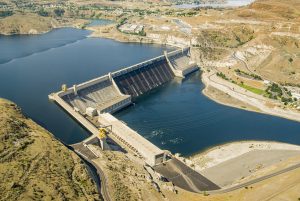
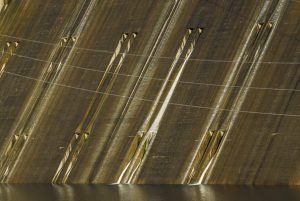
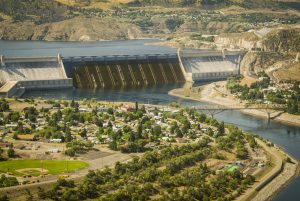
The Grand Coulee Dam on the Columbia River
NWNL I understand many of the irrigation farmers down along the Snake have reduced their water usage by 17%; and so with the new water to come down from Canada, they can keep irrigating, and also enlarge their irrigated farm acreage.
BRYAN JONES I’m glad to hear that they will have a new source for summer water supplies.
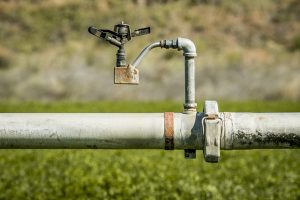
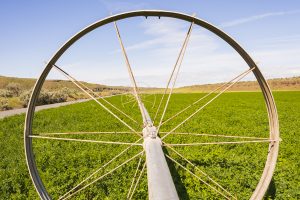
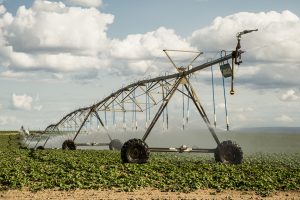
Irrigation methods in the Palouse
NWNL Your mention of the San Joaquin Valley and water scarcity for irrigators brings up the subject of your ground water supplies.
BRYAN JONES Our aquifer is certainly threatened. I don’t know when it’s going to run out. But most of that is not used for irrigation. It’s mostly used for the cities of Pullman and Moscow, their golf courses and other things that they’ve put in without thinking about how much water they’ll take. But we have to look at the long-term effects. The Ogallala Aquifer, southeast of here in the Dustbowl area that continues to be greatly tapped, has supplied many billions of gallons of water and tons of produce of various kinds. What happens when that runs out? It is already greatly depleted.
NWNL In 2012, NWNL documented the Red River in Texas. There, the Ogallala Aquifer was down to 25% of its original volume. Texas Tech scientists told us of their plan for “managed depletion.” For the next 50 years, Texas pledges to use only use half of what’s there now. However the bottom of the remaining half is like that “Jello sludge” you talked about earlier. If depletion is like bankruptcy, then “managed bankruptcy” doesn’t sound like a very sustainable plan.
BRYAN JONES Yeah. They’re just going to run the Ogallala dry. What do you do? This is such a great country and we’ve done so many wonderful things in this country. But at the same time, we haven’t really taken a long-term look at what we should be preserving – especially regarding our water and our soils.
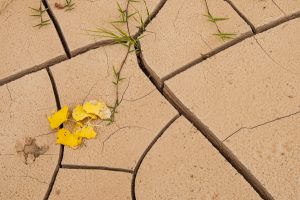
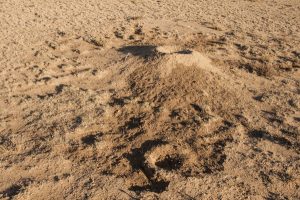
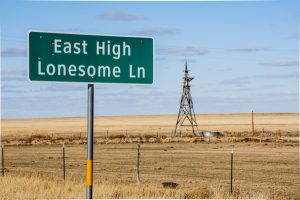
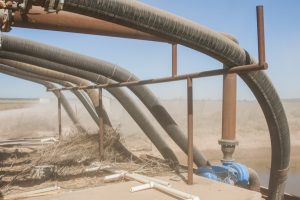
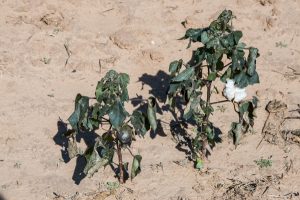
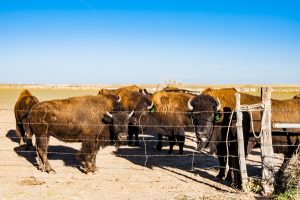
The Red River Basin in Texas, a Mississippi River tributary
BRYAN JONES I remember growing up and visiting little Sunnyvale, California, running around with walnuts and oranges dropping around me. I couldn’t believe I was in walnut and orange tree country. Now those orchards are all gone – replaced by housing developments. We’ve let our cities just spread out – like mold on cheese, our cities just keep spreading. Maybe we should’ve condensed those cities. Maybe we should’ve kept them little smaller, so we could have saved local farming. Today we are beginning to realize the value of locally grown produce.
Water is a critical issue and we aren’t going to get any more. We aren’t going to replenish any of our aquifers. Whether you believe in global climate change or not, something is happening. Our climate doesn’t seem to be the same as it used to be. Maybe we should do something about that. Maybe we should try to address water shortages and climate change. But there are those who don’t look at these situations in the same way, and that’s unfortunate. Historically man acts in an after-the-fact fashion.
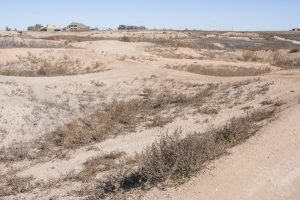
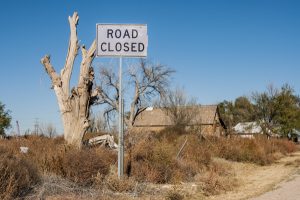
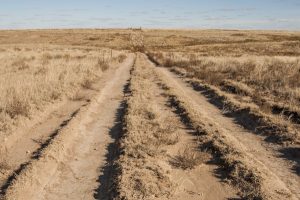
More of the Red River Basin in Texas
NWNL Are there water laws in Washington to protect the aquifers?
BRYAN JONES I’m sure there are. I am not accurately aware of just what is moving forward. I have my own well, and I do irrigate a little patch of alfalfa. But the issues I hear being discussed are what to do with water running off of irrigated fields – whether, or how, to contain it, keep it and let it settle out before it gets down into the water system.
Certainly, if nitrates in our groundwater reach a certain level at which our water is undrinkable, that’s an immediate health issue. We’ve had wells right down the road with nitrate levels that are too high. There’s been a well on this farm since before my father was here; and recently it’s been approaching higher nitrate levels. I’m not wild about that. The levels are still okay, but I don’t know a practical solution as yet. Our well is about 110 feet deep. I’m really lucky. There’s a lot of water there, and it’s been great water.
NWNL Is there any effort to replenish ground water here?
BRYAN JONES Some of the ideas being bandied around in Washington are about how to collect and save runoff water until it is needed. But, they haven’t come up with an area to store that water. Actually most suggestions I have heard make little sense.
They were going to put in a water system above the Columbia River’s Wanapum Dam. East of Othello WA on Crab Creek, they were going to flood that flat, vast wide-open valley of great habitat, farmland and communities. They were just going to make it into a giant shallow lake. That was just such a crazy, crazy idea because so much water would evaporate – not to mention the plan would destroy habitats, farmland and communities. Sometimes government solutions, which use taxpayer dollars, just don’t address the various consequences.
NWNL Can you tell us your position on dams?
BRYAN JONES Well that’s a little bit of a dance, because you can’t say all dams are bad. I can advocate for the removal of some dams, but still say, “No, no, not all dams.” They can be great, clean power suppliers if put in the right places. Not to mention, not all dams are equal. Some have good elements and some have proven to be terrible.
But, as we realized our ability to build dams in the late ‘40s and early ‘50s, we probably were overzealous. We used science then available to conquer and divide our river systems with dams. But today we can look at them and say, “Well-intentioned, but it didn’t really work out the way we would’ve liked it to.” The government didn’t look at all of the science then, and it still doesn’t today.
The reality is some dams aren’t appropriate anymore. Most of the dams are at the end of their lifespan, including the four Lower Snake River dams that I’m concerned about,. If it’s not effective to keep a 1950’s refrigerator, neither is it effective to keep a dam that is beyond its lifespan. How long do you want to keep repairing that refrigerator – or putting costs into that old dam system? Those are real easy facts that seem to me to say, “Okay, well, not forever.”
Ice Harbor and Lower Granite Dams: two of the Lower Snake River dams
BRYAN JONES It is expensive to maintain a dam system, and it is going to become exorbitant and economically unjustifiable. We will put more money into that old refrigerator or dam than we’ll ever get out of it in return or in power. The four lower Snake River dams are a perfect example. They generate little power and are costing billions in taxpayer dollars. Dam operation and maintenance is taxpayer dollars. Politicians spend our dollars as if they’ve got a piggybank and they can just shake it out. They don’t think about it. It’s just taxpayer dollars. It seems it is difficult for them to see or admit it when the economics are just wrong.
NWNL How important is it today for farmers to have the Snake River barge traffic that the dams make possible?
BRYAN JONES We spend $800 million dollars a year on the Snake River system on barging, dam repair, maintenance and all of the mitigation subsidies that go along with it – and we don’t blink an eye. It’s the second-largest environmental project in the country: $800 million dollars – almost a billion. And the system gives us very little back. It’s used for barging grain primarily, but we’ve found other better ways to move our grain, primarily rail.
The Columbia-Snake River barge system
BRYAN JONES In the Palouse, we’ve diversified what we farm. We’re growing different crops now. Nobody ships chickpeas and other crops down the river, because they get shipped differently. And so barging has declined dramatically. The amount of power generated by the four Lower Snake River dams is minimal – just a trickle – compared to that of other dams in the system.
A properly functioning country needs investment in its infrastructure. We need to build new rail infrastructure that would create a better way for farmers to ship grain. We’d be happy to reduce our tax burden in the long run by paying for an improved rail system today. In addition, that approach would save billions currently being spent on dams.
NWNL Why is rail a better method of shipping wheat than barge transport?
BRYAN JONES You can put a lot of grain on a barge; ship it down the Columbia; and then ship it to China or Japan, or wherever you want. You can do the same thing with a rail. But, what I like about rail is it offers other options. If I’ve got a different kind of wheat, or an alternative crop such as garbanzo beans, lentils, or canola, rail allows me to ship that product anywhere in the U.S – not just down the Columbia. Rail also allows for identity preservation in every container. I know exactly what’s in that container. Rail transport would allow me to raise – and process – a product locally, rather than just shipping out a raw product. That approach might be beneficial to all agriculture. I see it happening all across the country, so why not here?
NWNL Being able to ship processed produce is one advantage of rail has over barge transport. Are there any advantages rail has over barges for shipping wheat?
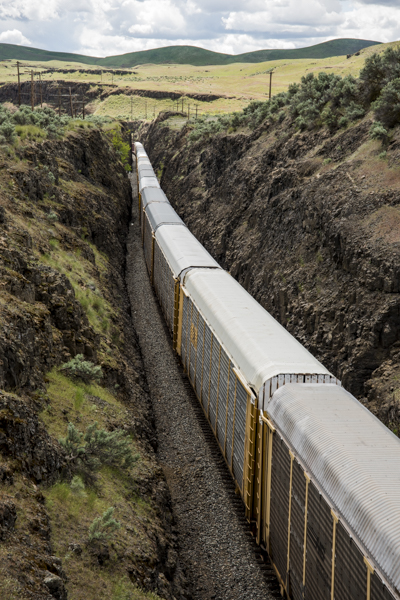
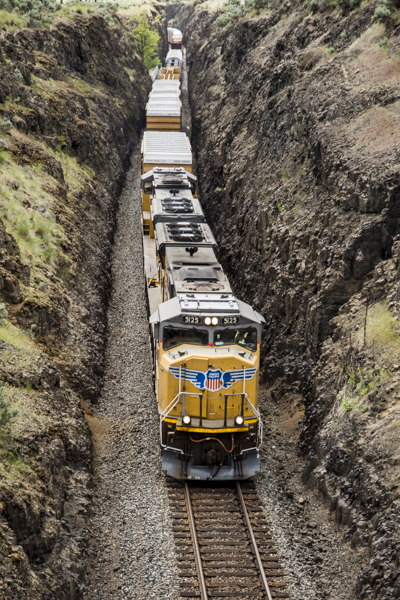
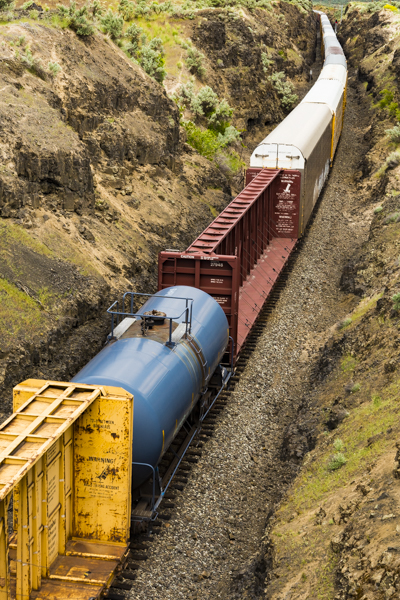
The Palouse freight rail system
BRYAN JONES We’ve learned that using a “unit train”(120 to 150 cars) becomes more efficient. The “loop rail systems” in Ritzville or Rosalia WA (about 45 or 50 miles from here) offer a new method to gather and ship wheat. With a loop rail system, railroad companies store a bunch of cars in one place that can filled, bit by bit, with products such as wheat. Once filled, they move down the system to Portland.
In moving 150 cars together, the rail company makes more money by hauling more cars. And having such a loop allows farmers to fill and move product in a most cost-effective manner. It gives us the ability to use different ports. Both Portland and Seattle want that business. If we could have a choice of ports to use, it would be great. Farmers really don’t care which way their grain gets to market. They just want to be paid for their product.
The Columbia-Snake River Basin freight rail system
NWNL It seems that minimal hydropower in spring runoff seasons and declining barge traffic supports the arguments of the Nez Perce Tribe and others fighting for dam removal. That would allow salmon runs to return to their spawning grounds above the dam sites, right?
BRYAN JONES Yes that’s right. If the dams come down, we’d have a great free-flowing river artery for those fish that leads into the Rocky Mountains. It’s critical that we do this. We’ve got this wonderful habitat for salmon and other anadromous fish, but no way for the fish to get there. They just don’t make it.
One could say, “We’d like to take out all eight dams between the Upper Snake, Clearwater and Salmon Rivers and the Pacific Ocean – but that is impractical. The dams on the Lower Columbia are giant power producers. There’s a lot of shipping that goes up and down that system. And so let’s be reasonable. Let’s pick the weakest link in the system. It’s been pretty well known for a long period of time that the four Lower Snake River dams don’t give us what they need to in order to be considered valuable.
There’s been much misinformation about the dams. The US Army Corps of Engineers and scientists should have been straight with the science from the very beginning. We needed honest assessments. When those who wanted to breach the dams began fighting with farmers perhaps a mistake was made. It could have been done much better. They should not have threatened us.
I personally hope and dream of saving salmon. However, I’m here to speak up for the wheat farmer as well. I don’t want to lose out on my ability to ship grain. I want to see salmon become a strong presence again in the Snake River, but it’s also important that wheat farmers have a way to get their product to market. And, so I got involved. It’s an important thing to me.
A Salmon Nation/Ecotrust 2007 Artists’ Project in Portland OR
NWNL How long would it take the salmon to return?
BRYAN JONES They’re knocking on the door.
NWNL But they still have to get through the Bonneville and three other dams on the Columbia River, downstream of the Snake.
BRYAN JONES Yes, they do. However, science seems to point to the fact that there are spawning fish above McNary dam, the fourth dam on the Columbia. Some do spawn in quite large numbers on the only free-flowing stretch of the Columbia. Others migrate upstream as far as they can. And some still come through the four Lower Snake River dams, but not in the kinds of numbers they once did.
NWNL How much increase in spawning salmon runs could be expected with the removal of the four Lower Snake River Dams??
Salmon bypassing dams on Columbia River system
BRYAN JONES When the dams went in, the recommended goal was a 4 to 6% return of the original salmon runs up past the dams. This number was deemed necessary to maintain a sustainable population. That number has never been met.
[Per Save Our Wild Salmon: In order to restore Snake River salmon populations to sustainable numbers, scientists have determined that they must consistently return adults to the uppermost Snake River dam, Lower Granite, at a minimum rate of 2% to 6%. Since 1975 when the eight dams (four on the lower Columbia River and four on the lower Snake River) were completed, return rates have only rarely exceeded the 2 percent survival minimum. From 1994 to 2004, they ranged from 0.35 to 2.5 percent, exceeding 2 percent in just a single year.
An extensive modeling effort completed in 2000 analyzed of the causes of mortality for Snake River salmon. The model demonstrated that the four lower Snake River dams were the most significant factor preventing recovery. The cumulative effect of eight dams on the lower Columbia and lower Snake Rivers is too much for salmon survival and if the four dams on the lower Snake were removed (cutting the total number of dams Snake River stocks face in half), these salmon can rebound to healthy levels….
A key benefit for Snake River populations is the amount of high quality habitat they have that is not found in the other Columbia basins. As a result of this extensive research, hundreds of federal, state, tribal and independent scientists have concluded that removing the four lower Snake River dams is the best and perhaps only means to protect these fish from extinction and recover healthy populations.]
I don’t know what the percentage is currently. All I know is it’s a very small number. At this point, we can’t imagine 6% of the native spawn returning – but, my goodness, just imagine 10 or 20%. I probably won’t see that in my lifetime. But, if we were to remove the four Lower Snake River Dams, we will have many fish that come back. They just find their way. They know it’s there. I don’t know how they know it. But they’ll come knocking. They’ll be in that system.
The Kennebeck River in Maine offers a great example: shad came up that river within six months after its dam removal. There was a stream – and they just had to be in it. It’s like a puddle, and a kid. He just has to be in it.
NWNL More fish would nourish the upstream ecosystems, feed humans and support other species. However, if the four Lower Snake River Dams were removed, what would there be downstream impacts of the released sediment built up in those reservoirs?
BRYAN JONES The sediment is going to be horrendous. But it’s got to go where it will. Rivers always recover. We’ve seen it over and over and over. Then weeds grow. Grass grows. Wildlife thrives. It’s going to be ugly to start with, but when you restore an ecosystem along this river, wildlife’s just going to bound back to life. It will all come back.
NWNL I’m sure you’ve seen the video of the 100-year-old Condit Dam coming down on the White Salmon River, another tributary of the Columbia. In 2007, I photographed the Condit and then 4 years later I watched the live-stream of it being blasted open. Sediment exploded out with such great force.
BRYAN JONES It was black.
NWNL Yes! But I returned this week to see the results. The condition of the dam’s former reservoir today is a great testimony to Nature’s powers of restoration – just as you say. I also documented the amazing reforestation program by local Yakama Indians.
The White Salmon River – with and without the Condit Dam
BRYAN JONES Of course. And everybody will jump in here, after the removal of the four Lower Snake River Dams. We will have a river we can recreate along. That’s been taken away from us. We don’t have access to that waterway like we did when I was a boy. There are now only two main access points to the river in a 60-mile stretch besides the highway on the north side of the Snake: Central Ferry and Boyer. That seems a shame.
NWNL Can people access those recreation points now? Can they haul their boats down there and go fishing?
BRYAN JONES Yes, Boyer is really the only area where people go to recreate. Central Ferry once a state-owned park there, but it has been closed. I think one can still launch a boat there. People fish a lot for bass, and I suppose a few people fish for salmon on occasion. You can eat the bass if you want. You certainly can eat the salmon. But there’s not much else there to fish for other than sturgeon at the base of dams, I suppose. People water ski. They play. They do what people do in any water system.
NWNL If the dams were gone and you had a working river with more access and more recreation, would there be a significant economic benefit from tourism and recreation?
BRYAN JONES People would come and raft those rivers. They would fish those rivers. Fishermen would come from a long ways away if you had really a vibrant salmon habitat. As a young boy I remember boating on the Snake. Access could be available in several more places along the river. There also could be opportunities for little communities to thrive. Who knows what communities might spring up along the Snake because of the opportunity to fish salmon? The main benefit in that scenario would be from those who would come to fish salmon. Salmon would be the economic mover on that part of the Snake.
Fishing along the Snake River
NWNL If there are only two access points now, are there other access points that could be opened – perhaps on land currently owned by the Bureau of Land Management?
BRYAN JONES Well, the United States Army Corps of Engineers [USACE] owns all land within a quarter mile of either edge of the river. And there are railroad tracks on the north side that you should not cross. Every time I’ve spoken to the rail companies about taking my 12-foot aluminum boat across the railroad tracks, they just get really antsy about me being there. And if I leave it on the shoreline for very long, I get a threatening letter from the USACE.
I use my boat for fishing with my nieces and my nephews and most any little kids that show up. Then they too throw bobbers out and are happy. Those threatening letters ask, “What would happen if everybody were to take advantage of the river and park their houseboats and fishing boats and set up camps?” All this suggests the USACE does not want us to recreate along the river. Just a hunch.
Boating on the Snake River
BRYAN JONES So economic benefits from recreational tourism will probably be improved with the removal of the four dams. The bottom line regarding dam removal is that the four dams aren’t very productive; an alternative system is needed to ship grain; and there would be restoration of a great number of wild fish to this system. We’ve succeeded in making this transition in a lot of small rivers, but we’ve never done it in a large river. This is the one place in the country I can think of where we could return a big river to its natural habitat and restore its natural wildlife.
NWNL How did you, as a dryland farmer, get involved in local non-farming issues?
BRYAN JONES Somehow through my upbringing it became important to have some element of environmental responsibility. And if it rubs off on saving species, that’s important. I care about saving salmon in our rivers, but I’m not just focused on salmon. I grew up on this farm, and we had thousands and thousands of Columbia ground squirrels. Those ground squirrels made habitat for burrowing owls. They made habitat for a badger. They made life easier for a cottontail rabbit and a jackrabbit (for which I don’t really have an official name), and all of the animals that went along with it.
I grew up on this farm, and now I’m a fourth-generation wheat farmer who has seen the demise of the ground squirrel. I remember seeing burrowing owls in my hillsides and badgers that scared the snot out of me. I shot them every chance I got because they were raiding my chicken house, eating my duck eggs, or whatever. I watched them all disappear.
Ground squirrel and bird species found in the Palouse
BRYAN JONES I regret that those are all gone. Every one of them is virtually gone from this country, because we tilled over all the ground, or we poisoned them, or we trapped them, or did what I did. I could never imagine that I’d shoot the last squirrel on my property. And that’s now the case. There isn’t one squirrel around, as far as I can tell. I realized eventually I should be attempting to preserve this wildlife. If I had my druthers, I’d love to see that fullness of environment come back and continue.
NWNL Is there any discussion amongst farmers here about establishing wildlife corridors? Would each farm be willing to give up some land for wildlife habitat?
BRYAN JONES Truthfully, I’d rather see having more ground that’s natural and wild with habitat for other species without taking away our ability to control weeds, a big issue when you’re farming. If you plant native grasses, you must control the weeds and allow beneficial habitats establish themselves.
NWNL Could land be donated to create “species strips” that would be somewhat like the anti-erosion “grass strips” some farmers already have?
BRYAN JONES I know about that concept, but I don’t think that we’re looking at habitat corridors very much. With the advent of CRP [Conservation Reserve Program] setting aside large tracks of land for 10 to 15 years, different kinds of wildlife have come into this area that weren’t here at all when I was a kid. Every year elk pass through this country. Deer are everywhere. I’ve seen moose in the country.
Large mammal species found in the Palouse
BRYAN JONES A lot of species thrive on ground set aside by CRP and that’s been a good thing. I don’t know if we’re really talking about corridors. But when you get enough CRP tracks of land lined up together, it does make a nice habitat for certain species.
I’ve always lived 11 miles from the Snake River. And, in 2006, I met some people who were working diligently towards saving salmon. I became involved. I thought, “Yep, that’s a good idea. This is the best thing that we could do.”
NWNL Jim Waddell, retired from the US Army Corps of Engineers [USACE], talks about a lack of transparency in the recent film “DamNation.” He says the USACE 2002 conclusions, presented after 7 years of study, in the Lower Snake River Juvenile Salmon River Migration Feasibility Study were ignored. Do you agree?
BRYAN JONES I first learned of this feasibility study by the USACE from Jim Waddell.
[NB: Jim Waddell worked as a civil engineer for the USACE for 35 years and was the Deputy district Engineer for Programs in the Walla Walla District during the latter stages of the development of the feasibility study. To read his doubts about the validity of the data that lead to the decision not to breach the dams, read his Comments to the USACE Waterway Users Advisory Board at their meeting August 14, 2014 in Walla Walla WA.]
Although Jim was one of the authors, his information wasn’t taken seriously, and it wasn’t put into the study. It was ignored. And that’s unfortunate. You have to look at all of the science. To me, it’s crazy that it was ignored. The science probably should’ve been examined a long time before that. But Jim did the study and has gone through and revamped it now, so it now becomes really important to have his work vetted; and if correct, have it given to politicians and the public. We need to make sure that it’s accurate and that it’s valued. Even if his numbers get played with or changed any way, shape or form, I think there’s still plenty of room to prove the science supports the removal of those four Snake River Dams. It’s a shame to waste all of that time and money, but it’s got to be done. [NB: The draft of the feasibility study, 2 years before the final report, cost over $22 million to prepare per the US Government Printing Office.]
NWNL Bryan, there are many players involved in the decision to remove these lower four Snake River Dams. They include wheat farmers, the USACE, the EPA, the Nez Perce Tribe…. How can there be a win-win situation for everyone – a phrase you used in the “DamNation” film?
The Nez Perce Tribe’s cultural artifacts (in Nez Perce NP Visitor Center in Lapwai ID) and current Executive Director Rebecca Miles
BRYAN JONES The stakeholders involved do comprise a lot of diverse groups. It is a diverse group with varying interests. Some may have a hard time making a livelihood if they’re not able to ship grain by barge down a river. But there are options. To get Americans, government officials, farmers, and people who work in and around the river system to agree on something is going to be tough.
It’s not an easy issue. There are going to be arguments about who gets the fish. The lies about the power have to be dispelled and clarified. And we’ve got to explain what’s at stake to everybody involved and answer when they ask, “What’s going on with the system?” And then we’ve got to sit down and ask, “What are we going to do to fix it?”
I know it can be done. I’ve seen it once before. It’s miraculous. Around 2007, Ken Cassavanti pulled together a panel to talk about this issue. We butted heads all morning long, and there were some tempers flying. Tempers amongst fishermen were flying. There were those in the group that did not wish to participate. But they gave us a little food – lunch is always good – and a little time to rest. And in the afternoon we talked about solutions, how it could be done and how it could be made to work. I walked out of that room just knowing it could work.
NWNL What lessons from that negotiating experience can you apply to the debates still to be had over the fate of the four Lower Snake River dams?
BRYAN JONES At first, getting everybody in one room is going to be the critical thing. But if you bring people together, then it’s possible for them to agree. It’s just a matter of people being able to say, “I’m in a group.” If the conversation is in place and if you tell stakeholders, “This will mean something,” then you’ve got a way to start the monolithic task of moving forward. That will be a giant job in itself, but it’s a very do-able scenario. It’s just not easy.
“Ant and Yellow Jacket” – a Nez Perce lesson to be learned
BRYAN JONES I suppose I’d like to see a politician try to organize this; but it might be better for somebody from a university to pull a group together, with the right politicians sitting in the room. The political types need to be present because ultimately they are the ones who need to act on these decisions. Those were probably the people who were missing in the scene I just described in 2007.
NWNL Are there politicians in office right now who are open enough and not afraid of losing their jobs by taking a position to remove these dams?
BRYAN JONES There are politicians out there who say we should have a stakeholder meeting. There are politicians who have called for meetings. I think Governor Kitzhaber of Oregon has volunteered and wants to see the system moved forward. I don’t know what exactly he’s calling for, but he’s willing to come to a table, and that’s incredible. There have been a few Idaho politicians who have said that they were willing to look at the scenario.
Yet I’m pretty confident that my politicians in Eastern Washington are sticking on a line and not willing to talk about that topic. But they should know that a lot of farmers out here don’t think salmon should be extinct. And a lot of farmers out here find it interesting that the four Lower Snake River dams don’t really produce that much power. A politician should be listening to his or her constituents and saying, “Hmm, this is something that should be discussed. We can give farmers a solution. We can work this system out and ultimately save taxpayer dollars.”
I’m also confident that my federal politicians are probably trying to stay in office, and so consequently they won’t take a solid position, or call for a stakeholders’ meeting, or support dam removal. It’s probably still serious enough that they’d lose their seats.
NWNL What is the source of your motivation, support and dedication to the issues of removing the Lower Four Snake River Dams?
BRYAN JONES A lot of farmers out there agree with me. They don’t want to see salmon go extinct. We are asking what this country’s willing to do to save water, preserve species, and lengthen the time this country is the country that it is and was. We must reclaim a little of our natural past. Teddy Roosevelt called our National Parks the “heart of this nation.” And a very valuable thing he did. The National Parks are the hearts, our rivers are the arteries, and our role is to keep life flowing in and out and back and forth. We need to spend a little less on a lot of things, and a little more on preserving some environmental things.
The Snake River and Hells Canyon National Recreation Area
BRYAN JONES Teddy Roosevelt didn’t really use the term “environmental,” but I think “environmental” means saving the quality of life that we have in this country. And that’s critical. This is not a right or left, or a red or blue position. The question is just whether we want to keep this country doing well – or whether we just want to chew it up, spit it out; and see what’s left, letting our children’s children’s children deal with it.
That’s the message we’ve got to get out to the public.
NWNL I think if you can get the honest information out, it will speak.
BRYAN JONES Not too long ago, right here at this kitchen table, the DamNation film crew came to film my brother, a buddy who’s grown up here as a wheat farmer, and me. We had interesting interactions on questions such as what fish the Nez Perce are able to catch and what their role is currently. We also discussed the farmer’s perspective. But it was my rookie brother who asked the question that needed to be asked: “Well, why are the dams there anyway?”
We have to get the word out. The film “DamNation” has to keep moving around. We have to have discussions – panel discussions. I’ve attended only two panel discussions organized after the release of “DamNation.” On both occasions I felt as if I were speaking to the choir. The crowd for the most part agreed with the film. What I would rather see is somebody who makes me motivated, someone who gets in my face, or somebody who challenges us all so we can sell the truth. I would rather be challenged and go find the truth than just have the public agreeing with the movie.
I don’t expect to convert farmers, politicians or the public right on the spot; but I want to give them the information they need to come to a place where they accept the issues and can work to build a winning scenario for all those involved.
NWNL Thank you, Bryan, for sharing your insights gleaned through four generations and for your time today.
I don’t expect to convert farmers, politicians or the public right on the spot; but I want to give them the information they need to come to a place where they accept the issues and can work to build a winning scenario for all those involved.
Scenes from the Palouse
Posted by NWNL on Dec. 11, 2014.
Transcription edited and condensed for clarity by Alison M. Jones.
All images © Alison M. Jones. All rights reserved.
